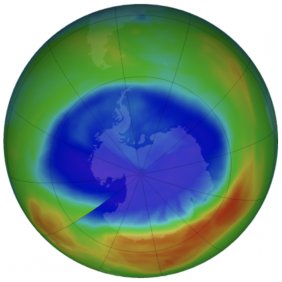
Thanks to the collaborative effort of nations around the world, ozone layer recovery is on track, helping avoid global warming by 0.50 C!
The destruction of gaseous ozone, O3, by chlorine atoms is an exemple of catalysis (homogeneous since chlorine atoms (which act as the catalyst) have the same state as the gaseous reactants O3). In the stratosphere (upper atmosphere), ozone in the ozone layer absorbs over 95% of the UV radiation reaching Earth from the sun, protecting human exposure from these harmful rays. With the progressive depletion of the ozone layer, more UV radiation can reach the Earth's surface leading to DNA's mutations. This can be associated with an increased risk of skin cancers (melanomas). Here are the chemical reactions leading to the damage of the ozone layer with the catalyst Chlorine atoms:
CF2Cl2 (g) giving (with UV light) CF2Cl(g) + Cl(g)
Chlorine atoms, catalysts, are produced in the reaction of a chlorofluorocarbon (CFC such as Freon CF2Cl2 ) with UV light previously released by air conditioning units, fridges, and aerosols.
Cl(g) + O3(g) giving ClO(g) + O2(g)
ClO(g) + O3(g) giving Cl(g) + 2O2(g)
Overall reaction: 2O3. giving 3O2(g)
Chlorine atoms act as catalysts. Indeed, they are regenerated in the second reaction and so, not consumed in the reaction itself.
The UN-backed Scientific assessment Panel to the Montreal protocol on Ozone depleting Substances, published every 4 years, confirms the phase out of nearly 99% of banned ozone- depleting substances has succeeded in safeguarding the ozone layer, leading to notable recovery of the ozone layer in the upper stratosphere! It's fantastic news and so encouraging for partnership in caring for the environment by inspiring and enabling nations and people to improve their quality of life without compromising that of future generations (reduce greenhouse gases) ! Jan/23
https://public.wmo.int/en/media/press-release/ozone-layer-recovery-track-helping-avoid-global-warming-05°c
https://ozonewatch.gsfc.nasa.gov
Source: Oxford Book Chemistry IB
